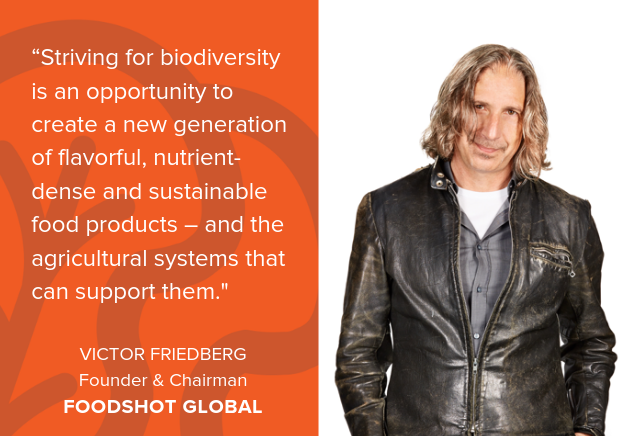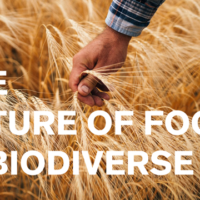
Food+Tech Connect and The Future Market are hosting Biodiversity: The Intersection of Taste & Sustainability, an editorial series featuring interviews with over 45 leading food industry CEOs, executives, farmers, investors and researchers on the role of biodiversity in the food industry. Read all of the interviews here.
Creating a regenerative and more biodiverse food system will requires significant investment. FoodShot Global is doing just that by helping innovators tackle some of our greatest food system challenges through its integrated capital platform of non-dilutive, equity and debt funding. Below, I speak with founder and chairman Victor Friedberg about white space opportunities and capital structures that can help us transition to a regenerative and biodiverse food system at scale.
_____________________
Danielle Gould: Is biodiversity a priority for FoodShot Global? If so, how and why?
Victor Friedberg: Yes, biodiversity is a priority for every organization I’ve built in the food sector. While I could argue for biodiversity as an end in itself, I would rather make the case that striving for biodiversity is an opportunity to create a new generation of flavorful, nutrient-dense and sustainable food products — and the agricultural systems that can support them. Consumers will drive the growth of this new biodiverse food system by voting for policies and practices that support its development, and, over time, businesses and organizations will reap the benefits of this biodiverse system by reducing risk (climate, supply, economic) and generating growth.
DG: What is FoodShot Global doing or planning to do to promote biodiversity?
VF: I founded FoodShot Global to identify global food system challenges and invest in groundbreaking solutions. With Sara Eckhouse, the Executive Director, and a world-class consortium of Founding Partners – including Rabobank, Generation Investment Management, MARS, the Innovation Institute for Food and Health at UC Davis, The Rockefeller Foundation, The Builders Initiative, Armonia and the Stone Barns Center for Food and Agriculture – we’ve built a capital continuum of non-dilutive, equity and debt funding to address global food system challenges.
In our inaugural year, we are focusing on healthy soil because it is the foundation of agriculture. Rich, biodiverse soils are essential to achieving the healthy, sustainable and equitable food system that will feed 10 billion people. In order to catalyze innovation to build a regenerative and sustainable soil system, FoodShot Global established the $525,000 GroundBreaker Prize for research, social enterprise and policy advocacy. We have also aggregated up to $10 million a year in equity investments and $20 million in debt financing. With our Founding Partners – and additional supporting partners ACRE Ventures, The Soil Health Institute, The Nature Conservancy, the Foundation for Food and Agriculture Research and Activant Capital – we leverage our collective thought leadership, networks, market access, pathways to commercialization and convening capacities to accelerate the development, deployment and impact of new techniques, technologies and breakthrough science that will enable soil to be the engine for a 21st century regenerative, biodiverse, nutrient-rich food system.
DG: What is the business case for products that promote a more biodiverse food system?
VF: The business case for healthy, biodiverse soil is simple: without it, eventually the economics of the planet will degenerate with the soil. We’ve set up an economic agricultural system in which we make massive withdrawals (nutrients, water, organic matter) with meager deposits. Nature is already starting to make its margin call, and the ripple effects of that on our agricultural system and for farmers has been profound – reduced yields, entire crop seasons wiped out, floods, drought and wildfires.
But beyond this macro frame for soil, there is a market case for building biodiversity into our food system. Food brands, whether CPG, food service or ingredient, will be seeking out unique and powerful flavors and new functionalities that differentiate them from their competitors and provide customers with unique food experiences. And just like investors diversity their portfolios to mitigate risk in the face of market volatility, we need to diversify our food system to reduce vulnerability to pests and disease that could lead to catastrophic crop failures.
DG: What investments need to be made to create a more biodiverse food system?
VF: Investments that prioritize biodiversity need to be made throughout the entire food system. When it comes to soil, these could include capital investments into soil analysis systems that measure soil fertility, nutrient content and compaction; soil inputs including bio-pesticides, inoculants and microbial seed coatings; intelligent farm management systems that offer predictive analytics; market innovations that increase the profitability of cover crops and crop rotations; and seed varieties that prioritize flavor and resiliency. At a systemic level, we need to invest in genetics that allow more diverse crops to compete in the marketplace, new ingredients that efficiently integrate biodiverse, nutrient-dense crops into food at a large scale, infrastructure to distribute fresher food that delivers to consumers the flavor and functional benefits of biodiverse crops, research that links the functionality of biodiverse crops and efficacy around human health, and support for the rural and indigenous communities that can grow biodiverse crops.
DG: How might we reinvent capital structures or create incentives to create more investment in biodiversity?
VF: There are existing capital structures that will continue to be effective at investing into brands, ingredients, agricultural products, services and land. A broad range of venture funds, including S2G Ventures, the one I co-founded, are doing incredible work in the sector. An increasing number of investors share common values around a more healthy, sustainable and equitable food system, and they see the opportunities to generate both financial returns and impact.
But shifting the food system and bending it back towards biodiversity will be difficult. Doing so at the needed speed and scale will require innovative models, including permanent capital, evergreen funds, land funds and real estate investment trusts that can provide time and resources for transition. This will allow the creation of virtual vertically integrated supply chains that are not owned by the brand/manufacturer but are so tightly bound by the specifications, agreements and incentives that they function as vertically integrated systems (with the potential for biodiverse and regenerative crops). We also need debt instruments that can be made accessible to farmers or structures that provide farmers with upside ownership for taking on the difficult work of transitioning to a biodiverse system.
DG: What are some of the most important things investors, food manufacturers, retailers and other key actors across the supply chain can do to support biodiversity?
VF: Identify, adopt and promote .
DG: What, if any, exciting products, technologies or services are you seeing that support a more biodiverse food system?
VF: One example is Dan Barber’s work at Row 7 Seed Company, an innovative, system-level start-up that is naturally breeding seeds for flavor and functionality rather than for yield and other efficiencies. Row 7 is using creative partnerships, such as the collaboration to incorporate the Koginut squash into SweetGreen salads, to market these crops. Another company I’m a co-founder of, Alpha Food Labs, is building biodiversity into the product development processes by leveraging the insights and early-adopter power of the Alpha community to create food products that use functional ingredients from various geographies and cultures.
There are also CPG companies with “hero” ingredients that are bringing biodiversity to grocery stores. Lavva, a best-of-class non-dairy yogurt, which I am the executive chair of, is a great example of the benefits of a biodiverse mindset. Lavva’s hero ingredient is the Pili nut, a tree nut with amazing emulsification properties and high mineral content from the volcanic soils in which it grows. Kuli Kuli is another company that is using a hero ingredient by building a product line based on the mainstreaming of Moringa.
Finally, Patagonia Provisions and the Land Institute have developed an interesting project to build a market for Kernza, a perennial long root grain. On the soil biodiversity systems perspective, there is a tremendous amount of innovative work being done to create biological soil inputs, inoculants, and microbial seed coatings, as well as new models and techniques for larger-scale farms that are implementing rotational farming.
DG: What is your vision for what a more biodiverse food system looks like in 10-15 years?
VF: The vision for the next 10-15 years is dependent on three macro frameworks:
1. First, that renewable energy becomes both politically and economically massive so that crops are no longer used for biofuels.
2. Second, that meat consumption continues to reduce in the Western world (partly through scaling of meat alternatives), that developing countries do not drastically increase meat consumption, and that large-scale regenerative meat farming becomes viable. These conditions must be met so that the massive, industrialized mono-cropped acreage currently dedicated to biofuels and animal feed can be reclaimed for agriculture that embraces biodiversity and meets consumer demand for biodiverse products.
3. Third, that agriculture is able to adapt to climate change and associated GHG levels. A recent Harvard report found that levels of carbon dioxide from human activity are making staple crops such as rice and wheat less nutritious and could result in 175 million people becoming zinc deficient and 122 million people becoming protein deficient by 2050.
The demand for biodiversity in food will come from both the ability of science to discover new ingredients and from the ability of innovative brands and chefs to promote the health and wellness benefits of the widest range of crops and flavors. In the world, scientists have identified about 1.75 million different species, including 950,000 species of insects, 270,000 species of plants, 19,000 species of fish, 9,000 species of birds, and 4,000 species of mammals. This is only a small portion of the total number of species on Earth. There are millions more species yet to be discovered and named. About 25 percent of the medicines used today are taken from or modeled on chemicals found in plants, animals, or other living things. We are just beginning to realize the human benefits of biodiversity.
We need to de-commodify commodities. We have built a food system that is designed to extract and discard identity, diversity and value from our crops. In the future, corn, soybean and wheat will be a smaller percentage of overall acreage in the world. Instead the future is our ability to be able to efficiently. And the enabling driver assumption is that soil biodiversity, through a broad range of solutions, whether low tech farm management best practices or high tech regenerative soil interventions have regenerated soil ecosystem diversity and organic matter.
Read all of our biodiversity interviews here and learn more about Biodiversity at The Future Market.
_____________________
 Victor E. Friedberg, Co-Founder, Seed 2 Growth Ventures (S2G); Founder and Chairman of FoodShot — MoonShots for Better Food ; Executive Chairman of Lavva ; Co-Founder of Alpha Food Labs
Victor E. Friedberg, Co-Founder, Seed 2 Growth Ventures (S2G); Founder and Chairman of FoodShot — MoonShots for Better Food ; Executive Chairman of Lavva ; Co-Founder of Alpha Food Labs
Victor has been at the forefront of innovation, global development and sustainability for over 20 years. As Co-Founder of S2G Ventures he has been a principal force in developing the S2G mission, culture, strategy and team. Through his work, he has pioneered system investing as a strategy for investing into food and agriculture and applied this approach in building the S2G portfolio. As Managing Director, Victor lead the S2G investments into Beyond Meat, sweetgreen, Ripple, Maple Hill Creamery, Apeel Science, Ataraxis. FishPeople and Lavva.
He is Founder and Chairman of FoodShot Global — Moonshots For Better Food an innovative investment platform to accelerate global food system transformation with partners Rabobank, Armonia, Generation Investment Management, MARS, The Rockefeller Foundation, The Builders Initiative, FFAR, The Innovation Institute for Food and Health at UC Davis and The Stone Barns Center For Food and Agriculture.
As Executive Chairman at Lavva, Victor guides forward-looking business strategy to establish pathways to brand aligned sourcing, manufacturing and new product development. He works collaboratively with the management team at Lavva to provide support for key opportunities and needs for the day-to-day execution of the business as needed.
He was named by Forbes Magazine one of the Top 25 deal makers and influencers in Consumer Products in 2016.





